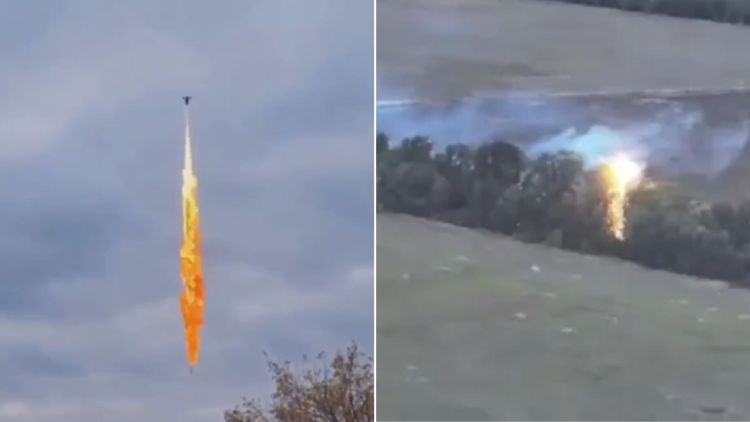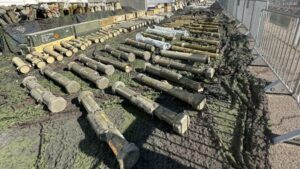In a dramatic escalation of the drone warfare tactics defining the Russia-Ukraine conflict, Russian engineers have unveiled flamethrower-equipped FPV (First-Person View) drones to counter Ukraine’s increasingly sophisticated unmanned aerial vehicles (UAVs).
Announced on November 14, 2024, through the Russian Telegram channel UAV Technician, this innovation underscores the evolving battle for dominance in the skies as both nations adapt commercial drone technology for military use.
Here’s what we know so far about the latest Russian military tech.
Flamethrower Drones
The reportedly newly developed Russian drones, equipped with small tanks of flammable liquid, project flames in a two-to-three-meter radius, aiming to disable Ukrainian UAVs mid-flight.
These drones are designed to counter Ukraine’s “dragon drones,” introduced in September, which deploy incendiary thermite payloads to disrupt Russian positions, set fire to treelines, and destroy equipment in forested and fortified areas.
According to Federico Borsari, a resident fellow at the US Center for European Policy Analysis, the Russian drones appear to be adapted “commercial quadcopter-type drone carrying a small tank filled with a flammable substance,” quoted from Defense News.
The flamethrower effect is achieved by spraying a flammable mixture downward, creating a short-range but potent countermeasure.
“This may work against drones that hover for observation,” noted Samuel Bendett, an advisor on Russian military technology at the Center for Naval Analyses. “But accurately targeting fast-moving UAVs like those used by Ukraine will be much more challenging.”
In a dramatic escalation of the drone warfare tactics defining the Russia-Ukraine conflict, Russian engineers have unveiled flamethrower-equipped FPV (First-Person View) drones to counter Ukraine’s increasingly sophisticated unmanned aerial vehicles (UAVs).
Announced on November 14, 2024, through the Russian Telegram channel UAV Technician, this innovation underscores the evolving battle for dominance in the skies as both nations adapt commercial drone technology for military use.
Here’s what we know so far about the latest Russian military tech.
Flamethrower Drones
The reportedly newly developed Russian drones, equipped with small tanks of flammable liquid, project flames in a two-to-three-meter radius, aiming to disable Ukrainian UAVs mid-flight.
These drones are designed to counter Ukraine’s “dragon drones,” introduced in September, which deploy incendiary thermite payloads to disrupt Russian positions, set fire to treelines, and destroy equipment in forested and fortified areas.
According to Federico Borsari, a resident fellow at the US Center for European Policy Analysis, the Russian drones appear to be adapted “commercial quadcopter-type drone carrying a small tank filled with a flammable substance,” quoted from Defense News.
The flamethrower effect is achieved by spraying a flammable mixture downward, creating a short-range but potent countermeasure.
“This may work against drones that hover for observation,” noted Samuel Bendett, an advisor on Russian military technology at the Center for Naval Analyses. “But accurately targeting fast-moving UAVs like those used by Ukraine will be much more challenging.”
Ukraine’s Dragon Drones: The Tactical Challenge
Ukraine has been highly effective in adapting commercial drones for military purposes.
Its FPV drones, including the thermite-dropping “dragon drones,” have proven devastating. By delivering molten thermite onto Russian positions, these drones destroy equipment, dislodge troops, and disrupt supply lines.
Ukrainian UAVs have even targeted Russian Mi-28 attack helicopters, demonstrating their precision and offensive capability.
Beyond the physical damage, these drones are psychological tools, forcing Russian troops to constantly adapt to unpredictable aerial threats.
The ability to evade traditional countermeasures and deliver payloads with precision has made Ukrainian UAVs a significant battlefield advantage.
Parallels with Flamethrower Innovations in Historical Warfare
For a quick look back: Flamethrowers have long been a tool of warfare, with their use tracing back to World War I and World War II, where they were employed to clear trenches, destroy bunkers, and flush out fortified positions.
Similar to today’s drones, flamethrowers were initially controversial but proved effective in delivering a mix of psychological impact and tactical value.
In World War I, the German Army introduced the Flammenwerfer, designed to devastate entrenched enemy positions. Its psychological impact was immense, creating fear and confusion among Allied troops.
During World War II, flamethrowers were further refined and became a key tool for the US Marine Corps in the Pacific theater, where they were instrumental in clearing heavily fortified Japanese positions on islands like Iwo Jima and Okinawa.
The flamethrower-equipped FPV drones of today share a similar mix of terror and utility, albeit in a modern, unmanned form. Instead of soldiers carrying these incendiary weapons, drones now deliver firepower remotely, reducing the risk to operators and enabling precision attacks.
Challenges for Russia’s Countermeasures
While innovative, Russia’s flamethrower drones face critical limitations, just like historical flamethrowers.
Analysts like Borsari point out that the fuel capacity of these drones allows for only a single sortie before requiring a refill.
Furthermore, prolonged use of the flamethrower can generate heat that risks damaging the drone itself. Achieving the precision needed to intercept fast-moving UAVs mid-flight also presents significant challenges.
This tactical innovation highlights the urgency driving Russia’s countermeasures as both nations continue to adapt and escalate their use of drones in warfare.
While the flamethrower-equipped UAVs aim to address immediate battlefield challenges, their development also underscores a broader trend in drone technology—a trend that extends far beyond the military applications seen in the Russia-Ukraine conflict.
In the US, companies like Throwflame have developed attachments such as the TF-19 Wasp for industrial uses, including clearing debris.
Similarly, China has integrated flamethrowers into drones for tasks like waste management and power line maintenance. These dual-use technologies demonstrate how innovations initially designed for civilian purposes are being repurposed for military applications.
The Drone Arms Race
The Russia-Ukraine conflict has become a proving ground for rapid advancements in drone warfare.
Both sides continue to innovate, with Russia’s flamethrower drones joining a growing arsenal of countermeasures aimed at neutralizing Ukraine’s technological edge.
Meanwhile, Ukraine’s offensive strategies showcase the power of adaptability, using commercial drones to create cost-effective yet highly effective tools of war.
In a modern twist on an old concept, flamethrower-equipped FPV drones evoke the historical use of flamethrowers in war but elevate it with remote operation and precision targeting.
Whether these drones will prove decisive remains uncertain, but one thing is clear: the evolution of flamethrower technology—from trenches and bunkers to the skies of Ukraine—demonstrates the enduring relevance of firepower in shaping the battlefield.



